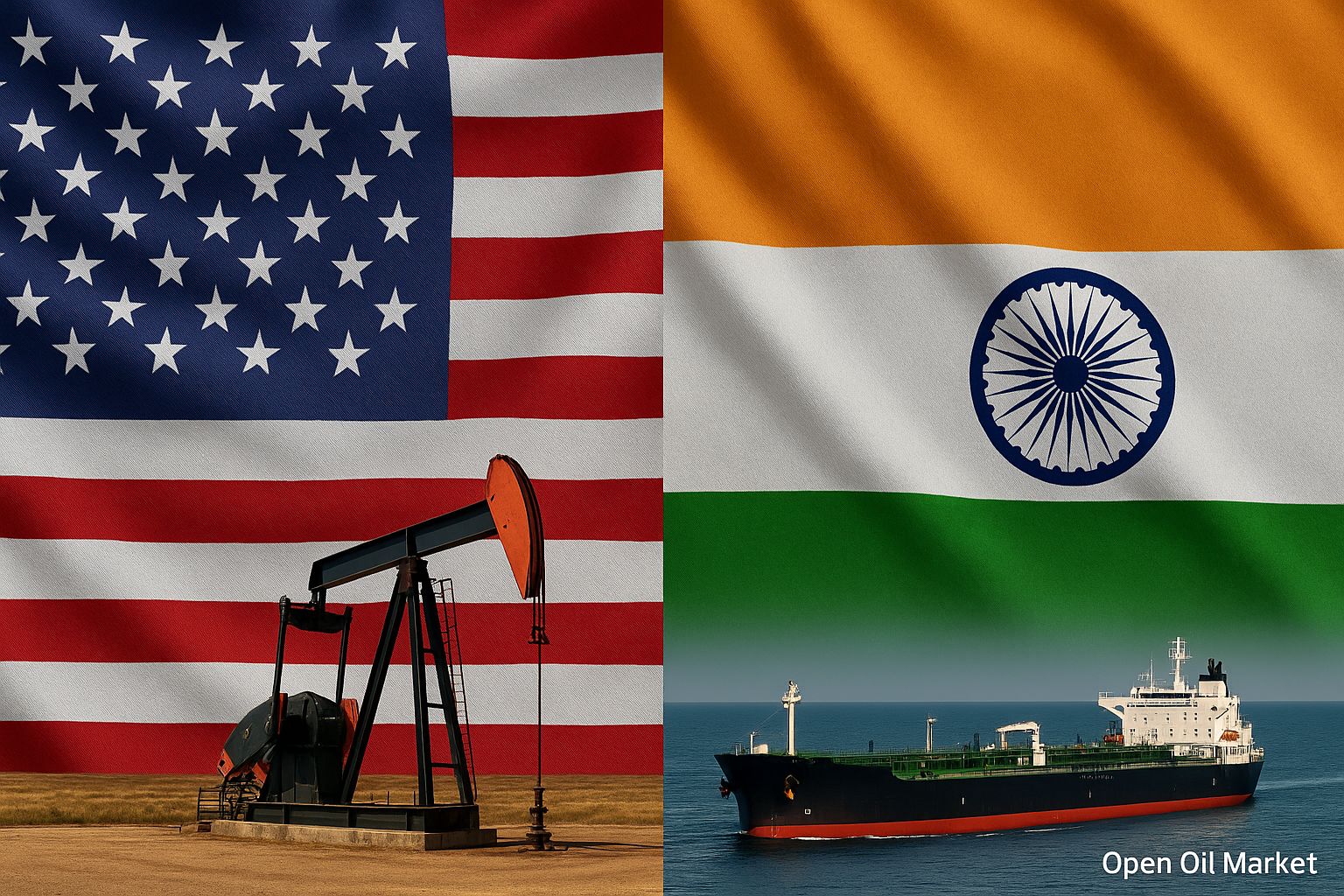News from the Fuel and Energy Sector, Wednesday, August 6, 2025: U.S. Increases Duties for India, Oil Prices Decline
Current events in the fuel and energy sector (FES) on August 6, 2025, are attracting the attention of investors and market participants. The United States is intensifying sanctions against buyers of Russian oil, impacting the interests of major oil companies and international trade. Amid this geopolitical tension, global oil prices have decreased, while fuel companies assess production prospects under the OPEC+ agreement. Russia continues to impose restrictions on the export of refined oil products to maintain stability in the domestic fuel market. Meanwhile, Europe is ramping up gas reserves in preparation for winter, and a return to coal has been observed in the global energy sector amid rising prices and demand. Below are the details of these and other key news from the commodity and energy sectors.
Washington Threatens India with New Tariffs for Russian Oil
The U.S. has increased pressure on the second-largest market for Russian oil — India. President Donald Trump stated his intention to significantly raise customs duties on Indian goods, citing ongoing purchases of Russian oil by New Delhi. Previously, the U.S. introduced a baseline tariff of 25%, which could be raised further within a day (by August 6). Trump expressed extreme dissatisfaction that India continues to import energy resources from Russia and even benefits by reselling them. Furthermore, Washington has not ruled out the possibility of introducing prohibitive tariffs of 100% and even 500% on Indian exports to the U.S. if Russia does not resolve the conflict in Ukraine by the deadline set by the U.S. (August 8). These threats represent secondary sanctions aimed at limiting global demand for Russian hydrocarbons.
Such tough rhetoric is causing concern among investors and international trading partners. The Indian oil market is one of the largest in the world, and U.S. actions signal to all fuel companies the risks of secondary sanctions for cooperating with Russia. Experts note that the trade standoff between the U.S. and India could lead to a reformatting of oil supply chains: New Delhi may seek to source raw materials from other suppliers or demand discounts, while American importers might face retaliatory measures from India. However, U.S. officials indicate they are prepared to take such harsh measures to further isolate Russia in the global oil market.
New Delhi Rejects Claims and Points to Western Double Standards
India publicly responded to accusations and threats from Washington, calling them unjust. The Indian Ministry of External Affairs issued a statement highlighting that the country is compelled to purchase Russian oil and refined products to meet its energy needs since traditional suppliers have redirected volumes to Europe. Meanwhile, New Delhi noted that Western countries continue trading with Russia in many sectors. The European Union still acquires energy resources, fertilizers, and metallurgical products from Russia, while the U.S. imports various chemicals and nuclear materials. Against this backdrop, the Indian side points to “double standards” — demands to cease cooperation with Moscow come from those profiting from trade with Russia.
The Indian government stated that it would protect national interests and economic security. The statement emphasized that U.S. and EU criticism of India is unwarranted: at the beginning of the crisis, Western countries themselves encouraged India to purchase Russian oil to stabilize the global market, and now condemn it for doing so. New Delhi reminded that the goal of these purchases is to ensure stable and affordable energy prices for Indian consumers, a priority for one of the largest economies in the world. Analysts estimate that India may resort to retaliatory measures or increase focus on alternative partners, such as China or Middle Eastern countries willing to cooperate outside the umbrella of American sanctions, in the event of escalation of the trade conflict with the U.S.
Global Oil Prices Decline Amid Market Expectations
Oil prices are demonstrating a decline due to a combination of factors. On August 5, the price of benchmark Brent oil dropped below $68 per barrel for the first time in two weeks. Since the beginning of the month, prices have decreased by approximately 3%, negating the growth seen in July. Investors are taking profits, considering signals of a potential oversupply in the fall and signs of a slowing global economy. Additionally, the strengthening of the U.S. dollar and uncertainty surrounding Chinese demand have impacted market sentiment. As a result, oil companies have seen prices decrease to levels close to what is comfortable for OPEC+ (around $65–75 per barrel).
Analysts note that seasonal factors also play a role: the summer peak in fuel demand in the Northern Hemisphere is coming to an end, leading to a decrease in consumption as the vacation season closes. For example, gasoline demand traditionally declines in the fall, which is already becoming apparent in wholesale markets. Furthermore, geopolitical tensions — the threat of new trade barriers (such as the aforementioned U.S. tariffs) — intensify concerns about global economic growth. Some financial institutions are revising forecasts: several investment banks predict an average Brent price in Q4 2025 at around mid-$60, which is lower than current figures. However, many market participants believe that a significant price collapse is unlikely, as OPEC+ countries may respond with supply restrictions if necessary.
OPEC+ Maintains Cautious Production Increases
The countries of the OPEC+ agreement continue to balance the market, gradually returning production to pre-crisis levels. In August, the deal stipulates that eight key countries (including Russia, Saudi Arabia, the UAE, etc.) monthly increase total oil production. It has recently been announced that they plan to add another 547,000 barrels per day in September to aggregate quotas, which will allow them to fully lift previously imposed voluntary restrictions of 2.2 million barrels by Q4 2025. Nonetheless, there remain voluntary cuts of 1.65 million barrels per day extended until the end of 2026, the future of which will be discussed at the OPEC+ monitoring committee meeting on September 7.
Experts believe that the alliance will approach the issue of further production increases cautiously. Demand for oil traditionally decreases in the fall, especially considering the economic slowdown in Europe and China, so some analysts expect that OPEC+ may pause in October-December and not immediately expand quotas after September. Much will depend on the price environment: while prices around $70 per barrel satisfy most exporters, if prices remain confidently above this level, some countries may be incentivized to accelerate production increases to avoid overheating the market and losing market share. Additionally, new risks may arise from non-economic factors—such as trade wars and sanctions.
Expert Commentary: "The introduction of new trade tariffs by the U.S. may raise concerns about oil shortages in regional markets, which could prompt OPEC+ to increase production," noted Sergey Tereshkin, General Director of Open Oil Market, in an interview with RIA Novosti agency.
Thus, OPEC+ is closely monitoring external factors. If the U.S. indeed implements its threats and imposes restrictive tariffs against countries purchasing Russian oil, this could lead to a redistribution of raw material flows and even a temporary shortage in certain regions. In such a case, exporting countries, including Middle Eastern producers, are likely to find it necessary to compensate for potential supply shortfalls from Russia by increasing their own production. Overall, oil companies within OPEC+ maintain a wait-and-see approach: they have already benefited from the summer demand increase, and their task now is to prevent a new oil surplus in the market by smoothly adapting to changing conditions.
Russia Prolongs Restrictions on Fuel Exports
The Russian refined oil product market continues to operate under limited export supplies. The Russian government previously imposed a temporary ban on gasoline exports for all categories of suppliers, including major oil refineries (refineries), until August 31, 2025. This measure aims to maintain stability in the domestic fuel market during the peak summer demand period and the active agricultural phase. Initially, the restrictions applied only to independent traders and small refineries, but at the end of July, they were extended to vertically integrated fuel producers, effectively imposing a complete embargo on gasoline exports for a month, with the possibility of extension into September.
The government notes that the export restrictions enable additional supplies of fuel to be directed to the domestic market. Major oil companies have increased gasoline shipments to domestic exchanges, helping to stabilize wholesale prices somewhat. At the end of July, prices for gasoline grade Ai-95 on the St. Petersburg International Commodity Exchange reached a historic high, approaching levels seen during the crisis in 2023. However, at the beginning of August, the price growth ceased. According to the Ministry of Energy, the current balance in the domestic market is surplus, and if the trend persists, retail prices at gas stations remain under control. Additionally, authorities are considering mechanisms to stimulate fuel sales domestically (such as raising trading norms on the exchange) and other measures to prevent shortages at gas stations. For Russian fuel companies, the temporary ban means they need to flexibly manage export and processing flows, adjusting logistics in favor of the domestic market.
Gas Market: Europe Accumulates Reserves, Transit Restructured
European countries are actively preparing for the upcoming heating season by increasing gas reserves. As of early August, underground gas storage facilities (UGS) in the EU are filled to approximately 70% — with over 74 billion cubic meters accumulated. Since the injection season began (end of March), over 38 billion m3 have been injected, and energy market investors are closely monitoring the filling rates. The European Commission’s goal is to reach a UGS filling level of no less than 90% by November 1, and currently, the injection schedule is close to plan. Leading consumers, such as Germany, France, and Italy, have already exceeded the 60-80% mark in their storage filling, instilling confidence in energy supply stability for the winter. The situation is eased by relatively mild summer weather and consistently high supplies of LNG from various global regions.
Against the backdrop of sanctions and geopolitical factors, the structure of gas supplies to Europe has changed significantly. Since January 2025, transit of Russian pipeline gas through Ukraine has completely ceased (after the contract with Gazprom expired). The only route for direct supplies from Russia remains the "Turkish Stream" gas pipeline and its land continuation to Southern Europe. Currently, approximately 48-50 million m3 of gas is being pumped daily through this corridor, which is about 7% more than last year, partially compensating for lost volumes. Meanwhile, northern European routes are halted: the "Yamal-Europe" pipeline is not in use due to mutual sanctions, and the "Nord Stream" has been incapacitated following the sabotage in 2022. Therefore, Europe has increased reliance on LNG imports, and LNG receiving terminals are operating at high capacity.
It is also important to mention the situation regarding gas supplies to the Russian exclave. On August 4, Gazprom resumed gas transit to the Kaliningrad region via the gas pipeline through Lithuania after a 9-day pause. Previously, the region's supply was ensured through the floating LNG terminal "Marshal Vasilevsky," which temporarily replenished supplies during transit interruptions. Such pauses have occurred several times a year and are related to Gazprom's logistics: the company periodically sends its floating gas storage tanker for loading from the LNG plant "Portovaya" near St. Petersburg. Although these technical maneuvers are driven by sancion limitations (against the Russian gas shipping fleet), they do not significantly impact the European market — the volumes are relatively small. Nevertheless, the contract between Russia and the Lithuanian operator for transit to Kaliningrad expires at the end of the year, and experts do not rule out that Moscow may fully transition to autonomous LNG supply for the region if the agreement is not renewed.
In price terms, the European gas market has been relatively stable in recent weeks. Exchange prices fluctuate within a moderate range, well below last year's peaks, due to high storage levels and adequate supply. However, fall is approaching, and much will depend on weather conditions and global demand for LNG. If winter is cold or competition with Asian buyers for LNG supplies arises, European gas companies may face a new rise in prices. Thus, while the current situation is favorable, regulators and market participants in the FES in the EU remain vigilant, continuing to monitor infrastructure risks and stock levels.
Coal Industry: Price Growth and Return to Traditional Energy Sources
The role of coal as an energy source is again increasing on the global energy market. Coal prices in Asia are demonstrating an upward trend: according to the World Bank, the average price of Australian thermal coal rose to approximately $112.9 per ton in July. This marks the highest level since January of this year and the third consecutive month of increase (the price was around $109 in June). The rising prices of Australian coal are driven by sustained demand from electricity generators in the region. In comparison, South African coal prices fell to about $93.6 per ton in July; however, analysts attribute this to local factors and quality characteristics, whereas premium Australian coal remains in demand in Asian countries. The rise in coal prices reflects an overall trend: despite efforts toward a "green transition," the global economy continues to rely on traditional energy resources.
The United States serves as a notable example of a coal renaissance. According to official data from the Energy Information Administration (EIA), American power plants increased coal consumption for electricity generation by 19% in the first five months of 2025 compared to the same period last year. Electricity generation from coal-fired power plants reached 224 billion kWh, a record volume over the last five years. Consequently, coal's share in the U.S. national energy balance surged to 25%, meaning one in four kilowatt-hours in America is now generated from coal. This trend is driven by several factors: rising natural gas prices, the urgency to ensure energy system reliability, and the new administration's policies. President Trump, upon returning to power, lifted numerous environmental restrictions and set a course to increase production of all types of fossil fuels, including coal, to strengthen U.S. energy independence. Thus, American fuel companies and coal mines have been incentivized to ramp up production.
Experts note that the return to coal is not only seen in the U.S. In several large developing countries, coal consumption remains high, compensating for limitations on gas or oil. Simultaneously, the sector for renewable energy sources (RES) — wind and solar — continues to grow; however, their intermittency compels governments to maintain coal generation as a reserve for peak load situations. The International Energy Agency predicts that global electricity generation from coal will gradually decline after 2025, yet the current year demonstrates how challenging it is to immediately abandon coal without risking energy systems. For investors in the FES, this signals that traditional segments — coal, oil, and gas industries — will remain significant in the coming years, although they will modernize under environmental pressures.
For FES Investors
Overall, Wednesday’s news paints a comprehensive picture of the global energy landscape: geopolitical factors introduce uncertainty and volatility; however, the sector adapts through resource flow reorientation and internal reforms. Oil markets are responding to the threat of sanctions and the changing balance of supply and demand, the gas sector is restructuring logistics and relying on reserve stocks, and the power industry is balancing decarbonization goals with energy security needs. Investors and FES companies in CIS countries and around the world continue to closely monitor these trends to make timely strategic decisions amid the new realities of the global energy market.




